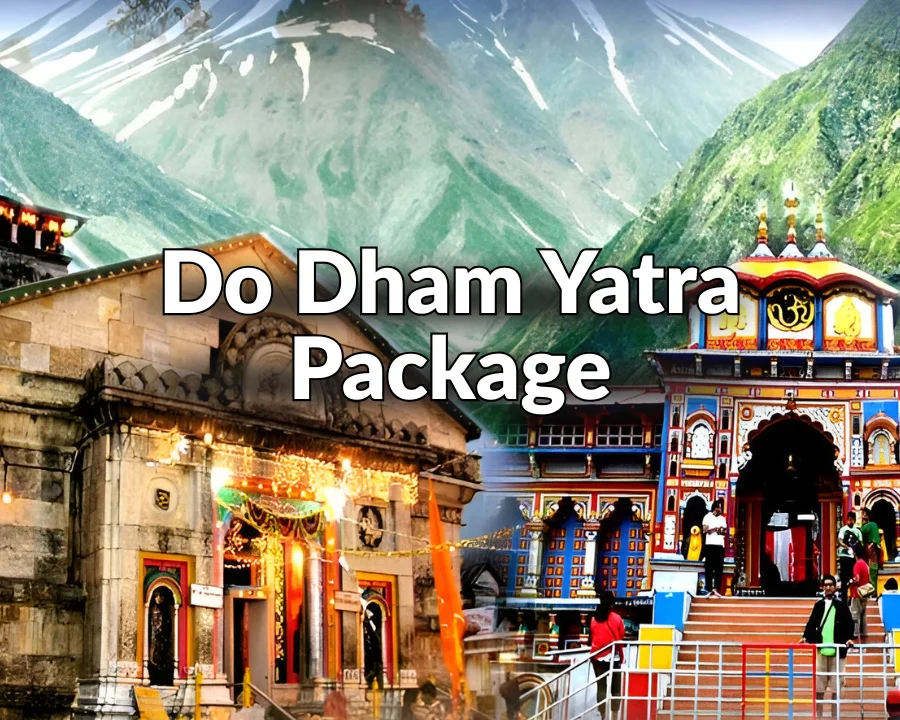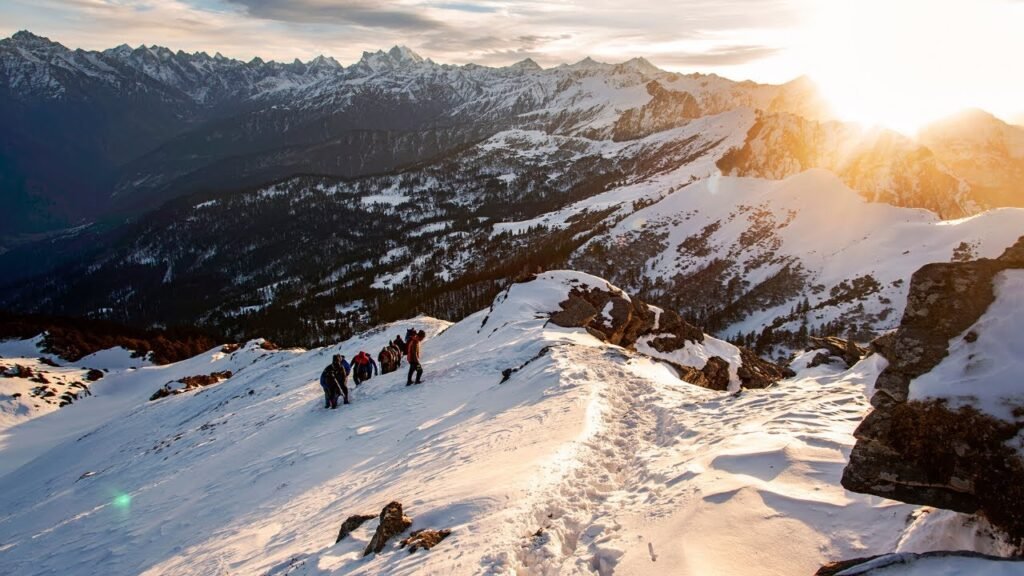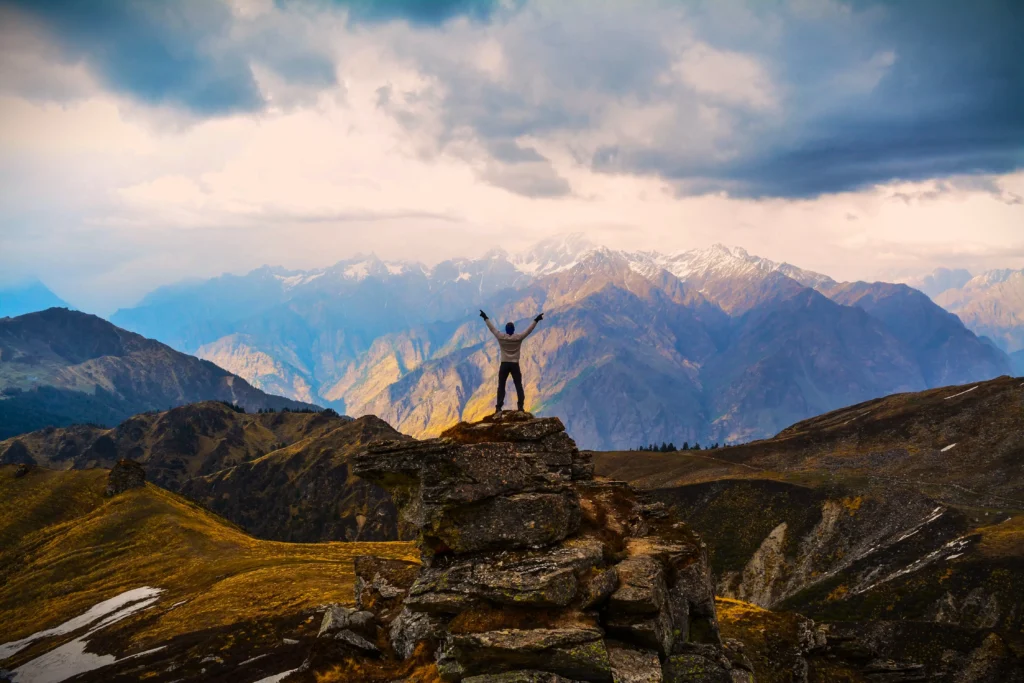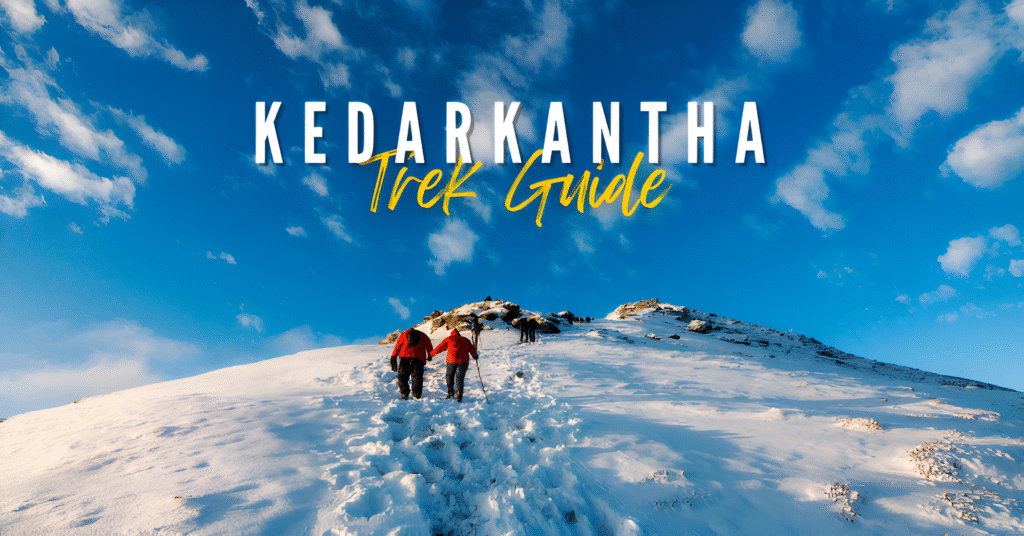
Now, picture yourself in the middle of a snow scape dotted with towering Himalayan ranges that are literally touching the sky. The air is cold and sharp, the silence as deep as space and the world across, down below seems a million miles away. This is no fantasy; it’s the beautiful Kedarkantha Trek, that serene trek in the heart of Uttarakhand, India. If you want to go for a trek which is splendid in more than one way, the Kedarkantha Peak Trek fits that ideal profile.
This journey is a passageway to the high Himalayas and an accessible trail for beginners leading into a land of snow-capped mountains, rich pine forests, and intriguing local culture. It’s not just a walk, it’s an experience that feeds the soul and leaves you with memories of silent campsites, roaring bonfires and sunrises transforming snow into shades of gold and crimson. Follow us we take you through all you need to know to experience this once in a life time winter trek.
Why Kedarkantha Trek is Special
There are several treks in the Indian Himalayas but Kedarkantha is special, especially in winter. It’s been known as the “queen of winter treks” — and for good reason.
A Real Winter Wonderland: Snow covers the trail from December to April and paints an idyllic white You can find the contrast between green plants and white snow absolutely amazing. It’s a unique feeling to walk in the freshly fallen snow while being gently showered with more falling flake.
Stunning 360 degree Summit Views: The view of the Himalayan peaks from the top (Kedarkantha Peak at around 3,810 meters) stretches out in all directions and you are left with a feeling of awe that will last for a long time. On a clear day, you can see famous peaks such as Swargarohini, Bandarpoonch, Kalanag and even the Gangotri range and Yamunotri range.
Easy, Adventurous and Exciting: That is the magic of Kedarkantha. It is attainable for people who aren’t very experienced trekkers and does not require technical climbing. However the gradual inclines, altitude and snow make it feel like a true adventure.
Scenic Campsites: Campsites on this trek are a treat by themselves. From the frozen Juda Ka Talab lake to the rolling meadows of base camp, each night is spent in a place you can only imagine under a blanket of stars.
Best Time to Trek Kedarkantha
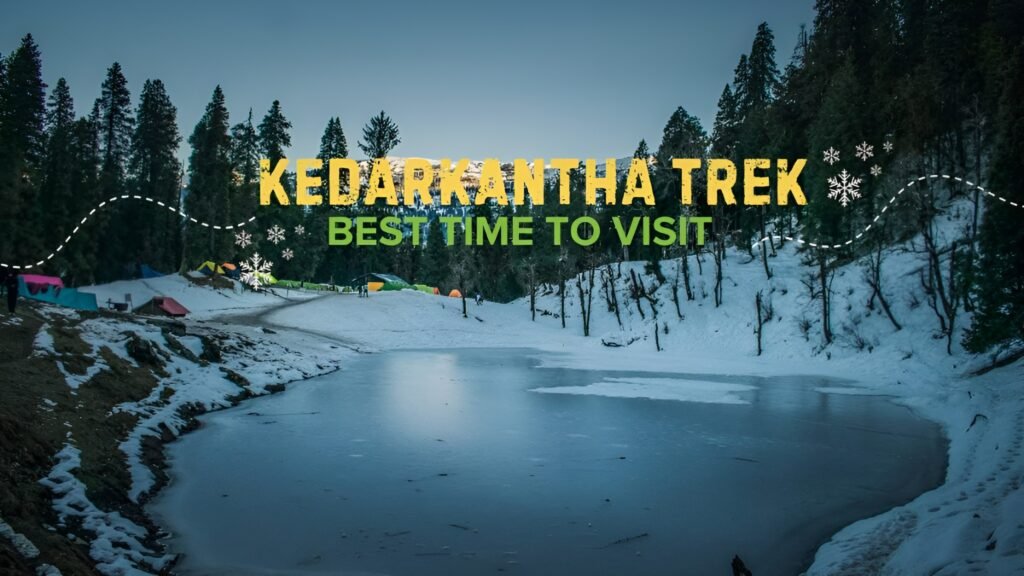
Kedarkantha is an all-season trek, but each season adds a unique flavor to this trek.
Winter (December – April)
Its the season and time for a snow trek. Snow is covering everything in sight and the scene on all sides resembles a postcard. It has sunny, crisp days and cold nights. Snow conditions make the trek a bit of an adventure.
Spring (May – June)
When spring snow begins to melt, the meadows are covered with brilliant greenery and colorful rhododendron flowers. The weather is nice and the treks are not crowded with many tourists making a brisk walk through to all these places. There are still amazing views of the snow-topped peaks.
Autumn (September – November)
Then, after the monsoon, the landscape is newly laundered and green. The atmosphere is among the clearest, providing some of the best and most spectacular view points along the Himalayan range. Spend time here between water sports and beach lounging in the Mediterranean sun, when it’s finally cool enough to play outside without dripping with sweat.
You should also try and avoid the monsoon season (July- August) when trails become wet leading to muddy conditions but tags or landslides.
Kedarkantha Trek Difficulty & Duration
Knowing exactly what you’ll encounter during your hike allows you to better prep for the trail.
Total Duration: 6 Days (Be it the trek or travel time to and from the base village, Sankri)
Trekking Distance: Approximately 20 kilometers
Elevation: 12,500 ft (High point) at Kedarkantha summit.
Difficulty Level: Easy to Moderate. (+6 The path is moderate and easy to follow. But walking through the snow of the mountains is physically demanding. It’s suitable for beginners not in need of technical trekking experience. It makes the perfect introduction to Himalayan trekking, catering a taste and experience for it.
You must be able to walk well for 4-5 kilometers and also have a good stamina. General fitness preparation, for example running, cycling or popping up and down the stairs in the weeks leading up to your trek is also advised.
Detailed Kedarkantha Trek Itinerary and Highlights
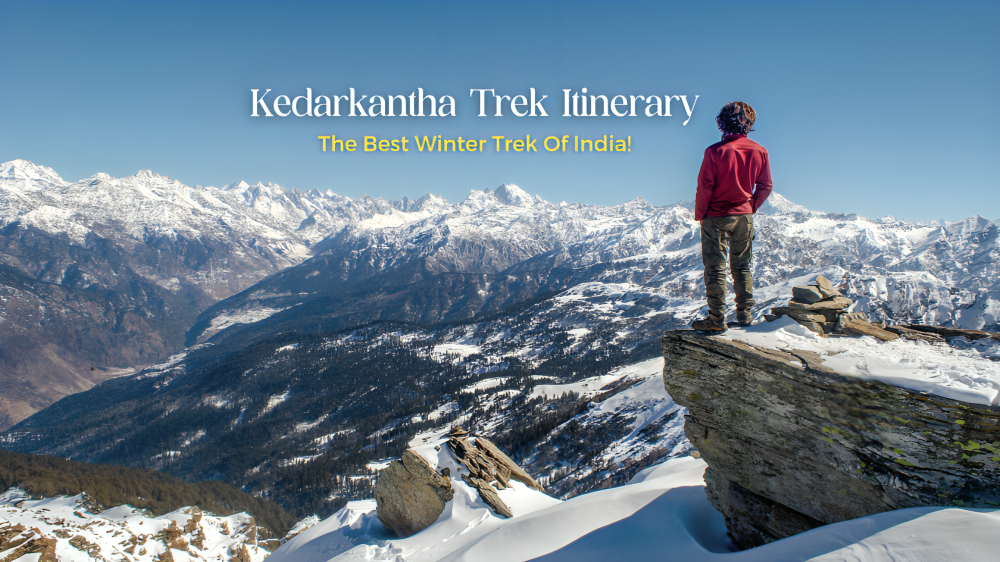
We designed our traditional 6-day itinerary for the best acclimatization and experience.
Day 1: Reach Sankri (6,400ft)- Base camp trek and drive The start of our Kedarkantha trek!
Your trip will start with a beautiful long drive from Dehradun to Sankri – the ‘base village’ for the Kedarkantha Trek. The road meanders through pine forests and streams alongside the Yamuna and Tons rivers, with framed views of the Garhwal Himalayas. Sankri is a charming village with few guesthouses and bustling market. Spend the evening getting used to the altitude and readying yourself for the climb ahead.
Day 2: Sankri to Juda ka Talab (9,100 ft)
Today, the real adventure starts! The Sankri to Juda ka Talab trek is approximately a 4 km hike and can be completed in 4-5 hours. The rocky trail ascends through thick stands of pine, oak and maple. In winter, this part of the hudson even with virtually no snow on shore.Scenic route!) is where you first see patches of snow. Juda ka Talab is a lovely little lake that turns into an enchanting frozen ice sheet during winter. The campsite is in a clearing, so build yourself a bonfire and lay out beneath the stars.
Day 3: Juda ka Talab – Kedarkantha Base (11,250 ft)
Post breakfast, you will head to the Kedarkantha Base Camp. The 4km trail is steeper today but with views that will give you a rewarding feeling afterwards. As you ascend, the tree line falls away to large meadows. Good initial views of the Bandarpoonch, Swargarohini and other peaks will unfold in front of you. Base Camp is a spacious clearing which provides you with unobstructed views of Kedarkantha Peak.
Day 4: Summit Day! 3 Act: Base Camp to Kedarkantha Peak (12,500 ft) and return to Hargaon Camp (8,900 ft)
Go about your life, until the day comes. The summit push starts before dawn. The climb to the top greets you with a difficult challenge, but an exciting beginning. The climb is done during the night, and you get to see an amazing sunrise over the Himalayas – a moment that will stay with you forever! At the top, your reward is a panoramic 360-degree view of snow-covered peaks. After enjoying the beautiful views, you’ll hike back down to the base camp for lunch before descending to Hargaon Camp.
Day 5: Hargaon Camp to Sankri
The final day you hike down to Sankri from Hargaon. The path snakes through thick forests and across ridges, with more spectacular views of the valley. On reaching Sankri, you can rejoice in successfully completing a trek.
Day 6: Departure from Sankri
Post breakfast and you’ll zip down to Dehradun with rich memories of an amazing Himalayan sojourn.
Essential Packing List
Packing smart will go a long way in making your trek a comfortable one. Here’s a checklist:
Clothing
Trekking pants: 2 to 3 pair ( No jeans)
T-shirts: 3-4 quick-dry t-shirts
Thermals: 1-2 of thermal tops and pants.
Fleece Jacket: 1-2 for layering
Jacket Puffy/Down: 1 to wear at night for the cold walls
Waterproof Outerwear: Poncho or rain jacket and pants
Socks: 4 to 5 pairs warm hosiery woolen socks.
Woolen Cap Gloves Neck Gaiter: Warm Basics
Footwear
Trekking Shoes: Water proof, High ankle with good grip
Gaiters To keep snow out of your shoes
Slippers/Floaters: (camp use)
Gear
A 50-60 L back pack: With a cover for rain protection.
Daypack (20L): To hold personal items during the day
Hiking Poles: Strongly recommended, Especially in snow.
Headlamp/Torch: With extra batteries
Bottles: At least 2L worth or a hydration pack.
Miscellaneous
First-Aid Kit: With personal medications
Toiletries: Toothbrush, toothpaste, biodegradable soap, lotion
Snacks: Energy Bars, Dry Fruits and Chocolates
Camera & Power Bank : For the wonderful pictures of the landscapes
Tips for First-Time Trekkers

Establish a Fitness Program: Start training at least one month prior to the day. Emphasis on cardiovascular activities such as jogging or cycling or swimming.
Acclimatize Right: “Listen to your guide, and stick to the schedule,” urges Karen. Don’t rush. Drink lots of water: stay hydrated, and your body gets used to the altitude.
Pack Light, Pack Right: Each and every gram matters on trek. Carry only what is necessary.
Strengthen Your Stride: Be a tortoise, not a hare. Keeping pace slow and steady will be great to save your energy for acclimatization.
Read the Signs: If you begin to feel sick (headache, nausea), tell your trek leader straight away.
Kedarkantha Trek Packages & Cost
The cost of Kedarkantha trek varies, an average indicative price would range from ₹8,000 to ₹12,000 per person (From Sankri to Sankri) for a reasonable good package.
Inclusions usually cover:
Accommodation (guest houses in Sankri, tents during the trek)
All trekking meals (meals are vegetarian & nutritious).
Trekking permits and forest fees
Professional trek leaders and crew members
The safety equipment (first aid kit, oxygen cylinders).
Trekking equipment such as sleeping bags, tents and kitchen utensils
Exclusions typically are:
Transport to and from Sankri
Personal spending money and gear for rent (shoes, poles)
Cost inflatable airliner or helicopter front zone charges for personal luggage.
Joining a reputable company like The Mountain Trekker means peace of mind, security and hassle free experience.
Kedarkantha : Ideal Winter Escapade for You
The Kedarkantha is the classic winter trek. The copious amounts of snow means it’s like a playground for people who love adventure. The excitement of stepping on fresh powder, the sound of snow compacting under your boots and the view of snow-laden forests will never leave you. It is not the same in winter as it is in summer, a quiet loveliness peculiar to this season. There are also fewer crowds on the trails, which means a more tranquil experience with nature.
Photography Guide
Kedarkantha is a photographer’s paradise.
Golden Hours: The best light is during the hours right around sunrise and sunset. The sunrise from the summit is a shot you can’t not take.
Snow Photos: Lens hood to avoid flare. Turn your exposure compensation (+1 or +2) so that your snow is white, not gray.
Provided in the property Night Sky- On clear nights, our area has stunning night skies with thousands of Stars. For long-exposure shots of the Milky Way, a tripod is essential.
Campsites: Make sure your document the life at camp – from tents glowing under stars to gathering around the bonfire and morning tea with a view.
Safety & Environmental Responsibility
Your safety is paramount. Never trek with a guide that not has been certified. Just know the weather and bring proper gear. It is also our responsibility to save the mountains. Use Leave No Trace principles: pack out all of your trash, do not disturb wildlife and be respectful of local terrain.
Local Culture and Experiences
The Kedarkantha Trek is not only about mountains, but also the people. The trail goes across the village were you will have homely and warm feel of Garhwali culture. Taste the local food, chat with locals and discover their lifestyle related to the mountains in a lot of ways.
Fitness Benefits of Trekking Kedarkantha
Hiking is a great way to boost your health and spirit. Heart Strength, Stamina And Fitness: Trekking the Kedarkantha peak would ensure you don’t just take back photographs and memories but also a stronger heart! More important, living close to nature — without the trappings of city dwelling for a week or two (or more) — can have lasting effects when it comes to stress relief and the health of both your body and mind.
Frequently Asked Questions (FAQs)
Is Kedarkantha Trek good for the beginners?
It is one of the best treks for beginners. The path is well defined and easy to walk up.
How much does it cool down in winter?
Nighttime temperatures can fall to -10°C. It is essential to wear warm clothes in layers.
Do I need a permit to hike it?
1 Park entry, Govind Pashu Vihar National Park Yes, you do need permit to enter into Govind Pashu Vihar National Park. This is generally organised by the trekking company.
Can I do this trek solo?
It is not so much dangerous in terms of and but it is probably best to follow a group or take a guide, especially during the winter.
What is the best season for photos?
Winter (Dec-Feb) is great for snowscapes and dramatic landscapes. Autumn (Sep-Nov) is when the sky is at its clearest for those wide-angle shots of faraway peaks.
Your Himalayan Adventure Awaits

The Kedarkantha Trek is an adventure that ensures thrill, tranquility and divine connection with nature. Get Essential Travel Information #15: Bedni Bugyal Known when the lush green meadow of Bedni Bugyal sprawls against the backdrop of imposing Trishul Parvat. Instead, it’s a chance to push yourself, see something truly stunning and make memories that will last a lifetime. From the snow-braided trails under star drapes, every minute on this trail finds enchantment.
Looking to see the Himalayas in their winter finery? Book your Kedarkantha Trek with The Mountain Trekker and we’ll take you on an experience of a lifetime!
For our trekking videos you can visit our Instagram Page: https://www.instagram.com/the_mountaintrekker/
If you loved reading about Kedarkantha Trek you might also like Brahmatal Trek , Brahmatal trek journey


